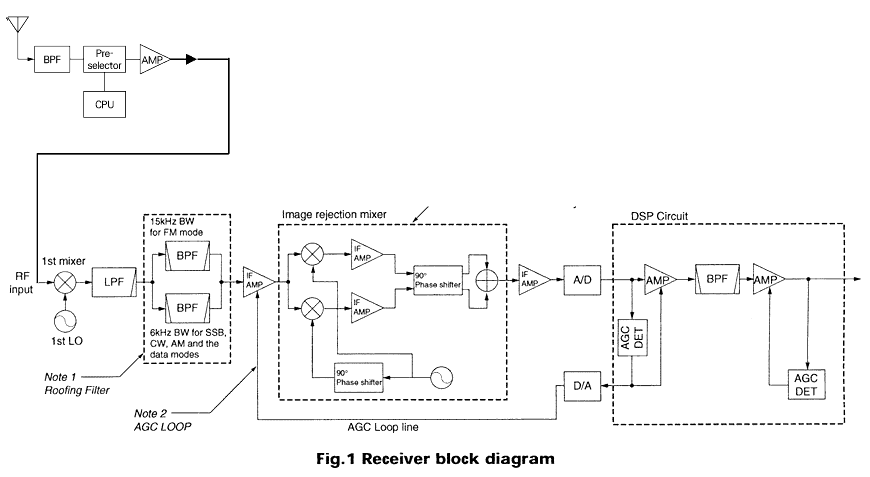 |
Figure 1 shows the RF bandpassfilters (BPF), preselector and preamplifier (AMP) ahead of the first mixer shown inthe IC-7800 receiver block diagram in Icom's IC-7800 Technical News handoutfrom Dayton 2003. The new Icom Japan IC-7800pages tend to confirm the concepts presented below. Onlythe HF range (exclusive of 6m) will be considered here.
RF Preselector (Digi-Sel): Initially, we assumed that the tracking preselector is not varactor-tuned. The JRC JST-135 HF transceiver employed a varactor-tuned preselector. A 6dB fixed attenuator at the preselector input served to minimise parametric mixing (in which a strong RF signal can modulate the varactors and generate unacceptable intermodulation products.) This attenuator also significantly degraded the receiver system noise figure (NF). The alternative to varactor tuning is a 2-stage synchronously-tuned BPF using relay-switched fixed capacitors and inductors, with either motor-driven air variable capacitors or additional relay-switched fixed capacitors for fine tuning. The new Icom Japan IC-7800 pages indicate a 100% relay-switched approach; this is mechanically simpler, and thus potentially more rugged and reliable.
RF Bandpass Filters (RF BPF): Our take on the RF BPF bank is that it will consist of third-octave filters with contiguous -3dB points, to allow general coverage. The filters are entirely relay-switched, to eliminate switching or PIN diodes from the RF signal path of the receiver. Switching diodes can generate intermodulation products under strong-signal conditions; PIN diodes insert loss ahead of the first active RF stage, thus degrading system NF. It is noteworthy that all high-end commercial and military HF transceivers use relay-switched RF bandpass filters - as do some amateur transceivers such as the Elecraft K2 and K3. The use of relay switching can significantly improve IMD2 and IMD3 dynamic range. The roofing filters following the first mixer are switched by NEC µPG2009TB GaAsFET switches.
Why is the RF BPF before the RF Preselector? Here is a comment contributed by Clemens Paul, DL4RAJ: "I have discussed this with a friend of mine who is a retired R&S HF engineer. He says that normally, the signal flow through selectivity elements is always from broader to narrower circuits. In this way, the preselector in the 7800 is somewhat protected by the BPF; one recalls the possibility of generating intermodulation products in capacitors at extremely high signal levels." Saturation of inductor cores will also cause intermodulation.
RF Inductors: One of the IMD-reduction measures employed in the IC-756Pro II front end was the redesigned RF BPF with inductors wound on larger cores, to avoid saturation at high signal levels. We are confident that this concept will be extended in the IC-7800, with physically larger inductors in the preselector, RF BPF, mixers and amplifiers.
RF Preamp/Attenuator: The IC-7800 offers two selectable RF preamps; one for the HF range, and the other for 6m. In addition, up to 18 dB of attenuation can be inserted in the RF signal path ahead of the first mixer. It is likely that both preamps will use high-current MMIC's, optimised and tuned for their respective frequency ranges. Again, we believe that relay (rather than diode) switching will be used here, for the same reasons as outlined in 2.
Roofing Filters: These are SMD fundamental-mode monolithic crystal filters (MCF), manufactured by Daishinku. The fundamental-type crystal filter, as opposed to a filter using 3rd- or 5th-overtone crystals, has a better shape factor and is less susceptible to intermodulation under strong-signal conditions. View a typical filter data sheet.
Note on the AGC gain-control point: It will be seen that AGC voltage is applied to the 64.455 MHz first-IF amplifier following the roofing filters. This is identical to the IC-756Pro II AGC scheme. The AGC gain-control point is thus well downstream of the point which determines the system NF (1st mixer or RF preamp). This indicates that Icom's designers have ensured that the linear RF/IF stages upstream of the gain-control point are sufficiently linear (over a wide range of RF signal levels) to be run "wide open". Operational experience with the IC-756Pro/Pro II has confirmed the validity of this approach. Click here for a general discussion of DSP-based AGC design, and here for an article on AGC in the IC-756Pro3, IC-7700 and IC-7800.
New: Icom Japan's English-languageIC-7800Pages now provide an extensive technical overview of the IC-7800, includingspecifications.
At an IC-7800workshop held at Tokyo HamFair 2003, Mr. Tokuzo Inoue, President of IcomInc., discussed receiver front-end design. Mr. Inoue raised a number of pointswhich tend to confirm several of our hypotheses. Also, the newly-published brochure "All About IC-7800" givessome further insight into the front-end design.
Copyright © 2003-2012, A. Farson VA7OJ/AB4OJ. IC-7800 block diagram courtesy Icom Inc.
Last updated: 09/25/2019